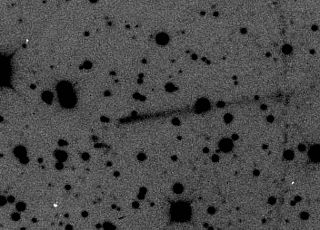A rock comet is a rare type of small Solar System body that exhibits features of both a comet and an asteroid, mainly in that it outgasses material primarily made up of grains of rock.

A small Solar System body (SSSB) is an object in the Solar System that is neither a planet, a dwarf planet, nor a natural satellite. The term was first defined in 2006 by the International Astronomical Union (IAU) as follows: "All other objects, except satellites, orbiting the Sun shall be referred to collectively as 'Small Solar System Bodies' ".

A comet is an icy, small Solar System body that, when passing close to the Sun, warms and begins to release gases, a process called outgassing. This produces a visible atmosphere or coma, and sometimes also a tail. These phenomena are due to the effects of solar radiation and the solar wind acting upon the nucleus of the comet. Comet nuclei range from a few hundred metres to tens of kilometres across and are composed of loose collections of ice, dust, and small rocky particles. The coma may be up to 15 times the Earth's diameter, while the tail may stretch one astronomical unit. If sufficiently bright, a comet may be seen from the Earth without the aid of a telescope and may subtend an arc of 30° across the sky. Comets have been observed and recorded since ancient times by many cultures.

Asteroids are minor planets, especially of the inner Solar System. Larger asteroids have also been called planetoids. These terms have historically been applied to any astronomical object orbiting the Sun that did not resemble a planet-like disc and was not observed to have characteristics of an active comet such as a tail. As minor planets in the outer Solar System were discovered they were typically found to have volatile-rich surfaces similar to comets. As a result, they were often distinguished from objects found in the main asteroid belt. In this article, the term "asteroid" refers to the minor planets of the inner Solar System including those co-orbital with Jupiter.

Rock comets, unlike other comets, which outgas primarily ice, have a nucleus made of rock. As a result, their outgassing can be unpredictable.

Ice is water frozen into a solid state. Depending on the presence of impurities such as particles of soil or bubbles of air, it can appear transparent or a more or less opaque bluish-white color.

The nucleus is the solid, central part of a comet, popularly termed a dirty snowball or an icy dirtball. A cometary nucleus is composed of rock, dust, and frozen gases. When heated by the Sun, the gases sublimate and produce an atmosphere surrounding the nucleus known as the coma. The force exerted on the coma by the Sun's radiation pressure and solar wind cause an enormous tail to form, which points away from the Sun. A typical comet nucleus has an albedo of 0.04. This is blacker than coal, and may be caused by a covering of dust.
Outgassing is the release of a gas that was dissolved, trapped, frozen or absorbed in some material. Outgassing can include sublimation and evaporation, as well as desorption, seepage from cracks or internal volumes, and gaseous products of slow chemical reactions. Boiling is generally thought of as a separate phenomenon from outgassing because it consists of a phase transition of a liquid into a vapor of the same substance.
The reason this happens is thought to be similar to how mud cracks at the bottom of a dry lake bed, leaving small chunks loose on the surface of the body, which later get pushed off it due to radiation pressure sweeping. [1]

Radiation pressure is the pressure exerted upon any surface due to the exchange of momentum between the object and the electromagnetic field. This includes the momentum of light or electromagnetic radiation of any wavelength which is absorbed, reflected, or otherwise emitted by matter on any scale.
Sometimes, an object can be mistakenly identified as a rock comet, such as P/2010 A2, an asteroid in the asteroid belt that collided with another object, causing it to have a field of debris trailing it for a short time. [2]

The asteroid belt is the circumstellar disc in the Solar System located roughly between the orbits of the planets Mars and Jupiter. It is occupied by numerous irregularly shaped bodies called asteroids or minor planets. The asteroid belt is also termed the main asteroid belt or main belt to distinguish it from other asteroid populations in the Solar System such as near-Earth asteroids and trojan asteroids. About half the mass of the belt is contained in the four largest asteroids: Ceres, Vesta, Pallas, and Hygiea. The total mass of the asteroid belt is approximately 4% that of the Moon, or 22% that of Pluto, and roughly twice that of Pluto's moon Charon.
Rock comets are rare because a rocky small Solar System body must come very close to the Sun, close enough for both the solid ground to crack, and for radiation pressure sufficient to push the separate pieces off the asteroid. However, if the asteroid is close enough to the Sun for the former, the latter will also happen.














